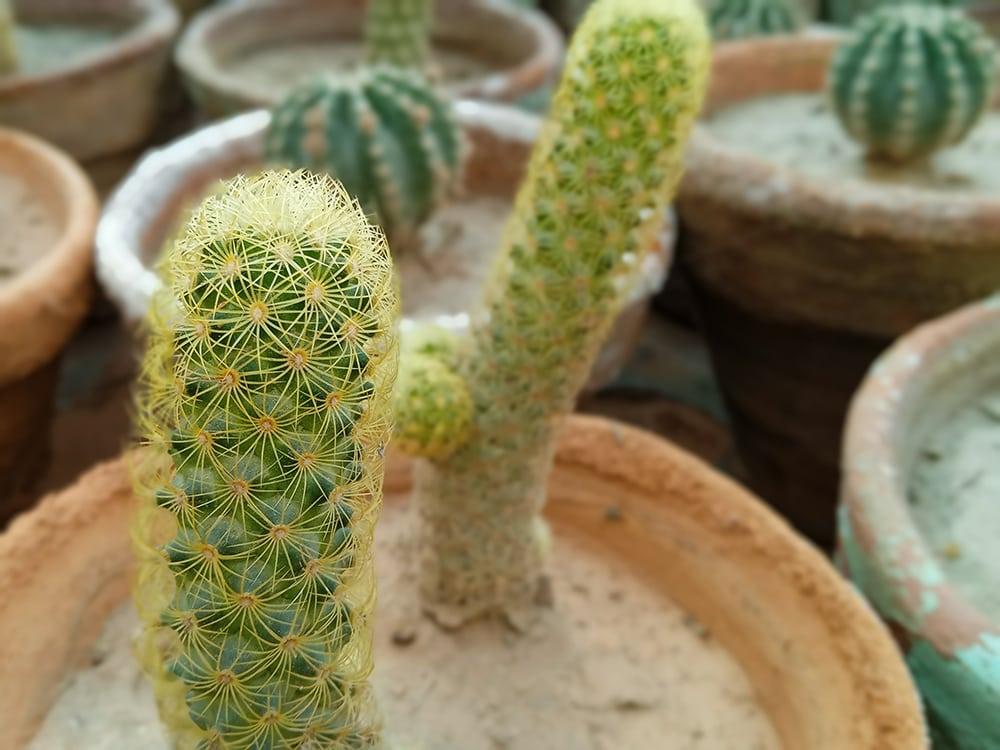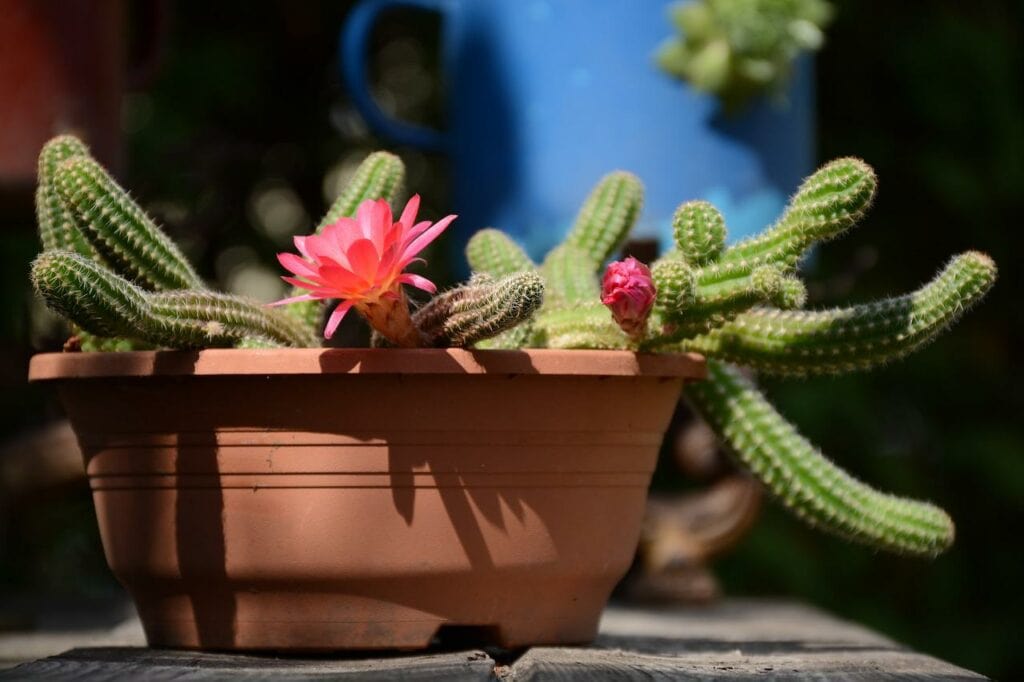Why Is My Cactus Turning Yellow? 8 Possible Reasons
-
Kristin Hitchcock
- Last updated:

Plants are a bit of an enigma. When they aren’t doing very well, they can display a number of symptoms. However, most of us don’t know what these symptoms mean, even if we feel like we should know.
Cacti are very similar. If you’re taking care of a cactus, you may have noticed that it is turning yellow. Obviously, this is a sign that something is wrong. However, exactly what is wrong can be difficult to determine.
There are actually many reasons why cacti may begin to turn yellow, and each of these reasons has a different treatment. Here are some of the most common causes, as well as how to cure them:
The 8 Possible Reasons Your Cactus is Turning Yellow
1. Not Enough Sunlight
Some cacti may yellow if they are not exposed to enough sunlight. Cacti need quite a bit of sunlight to grow and thrive, so they’ll often need to be placed by a sunny window. If your cacti aren’t getting enough light, they may turn yellow, which is a sign of stress.
If your cacti are in a dark corner, this may seem like the obvious reason. Therefore, you may want to move your cactus to a different location with more sunlight.

2. Too Much Sunlight
Many cacti require quite a bit of sunlight to thrive. However, there are many different types of cacti out there, and not all of them require significant amounts of sunlight. In fact, some only need a bit to survive and may get stressed if they get too much sun exposure.
Therefore, if you’ve placed your cacti in direct sunlight and it still isn’t doing great, you may want to research the particular species more. Some may require less sunlight and may need to be moved elsewhere.
3. Watering Troubles
One of the most common reasons a cactus may turn yellow is watering problems. Cacti are made to withstand droughts. However, they do vary in the amount of water they need. Some cacti need more water than others.
Therefore, it is very easy to overwater or underwater your cactus. If your plant isn’t in a pot with drainage holes, then the odds of overwatering it are high. All the water will simply sit in the bottom of the pot, leading to root rot and other root problems. You should always use pots with drainage holes for this reason.
At the same time, you should be relatively careful about underwatering your cactus, as well. Some cacti don’t require much water, but others require a bit. Many cacti grow wild in tropical regions that may get a decent amount of water, and this needs to be mirrored in your home.
It is best to research the particular species of cactus that you have and determine its water needs from there.

4. Low Nutrient Content
If the cactus isn’t getting everything it needs from the soil, it may eventually turn a yellowish color. This process is very similar to underwatering. The cactus simply isn’t getting what it needs and is therefore stressed, which makes it turn yellow.
Luckily, a succulent-specific fertilizer can solve this problem pretty quickly. Just be sure you get one that is designed for a cactus and follow the instructions on the container.
Since your cactus is already experiencing problems, we recommend getting a fertilizer that works right away. Time-release options can be good for keeping cacti healthy, but they are minimally helpful for helping a cactus now.
5. Temperature Changes
Some cacti don’t care what the temperature is. Others care a lot. If you move your cactus to a different location or change the temperature in your home, you may upset some cacti. Luckily, this typically isn’t a huge issue unless it moves the temperature out of the cactus’s range. In this case, you’ll want to adjust to ensure that the cactus is at the proper temperature.
If you must change the temperature for one reason or another, it is best to do it slowly. Don’t suddenly move the cactus next to the heating vent, as this can cause stress. However, most slow changes are well-tolerated, as long as you keep the cactus within its temperature range.
It can take cacti some time to recover from this change.

6. Pests
Usually, pests aren’t around inside our home. However, they absolutely can be in some situations. Mealybugs and spider mites are the most common. These build up on your cactus and suck the nutrients from its “leaves”. Eventually, this will leave you with a yellow plant.
Often, this only occurs after the plant has been infected for some time (or if something else is stressing out the plant, as well). In either case, treating the infestation is vital. Different pests have different weaknesses, but you often don’t need a chemical solution. Typically, regular household items are toxic to many plants but safe for our cacti. For instance, many pests die when they encounter dish soap.
You’ll need to do research on exactly what pest is causing the problem and what you can do to get them off your plant.
7. Diseases
Cacti can also be affected by a variety of diseases. These diseases can do a variety of things to the plant, but many of them will cause yellowing. One common fungal disease can cause “wilting,” which often looks like yellowing on the leaves.
In these cases, you’ll need to treat the fungal infection if possible. Not all infections are easy to treat but catching them early is vital to prevent the disease from passing on to other plants. Most are quite contagious and can infect plants beyond just cacti.

8. Chemical Exposure
If your cactus is exposed to harmful chemicals, it may no longer be able to use sections of its “leaves.” This may cause the plant to drop some sections of its body, which will turn yellow before they fall. For instance, chlorine, fluorine, and other substances can all be toxic in heavy amounts. Some of these are even found in tap water, as they aren’t harmful to people in small amounts.
If you expect contamination, there usually isn’t much you can do besides preventing further contamination.
 In Conclusion
In Conclusion
There are many issues that can cause your cacti to yellow. Luckily, many of these are easy to fix. For instance, if your cactus isn’t getting enough sunlight, you can move the plant to a different location. If watering is an issue, simply change your watering routine or add drainage holes to the pot. Alternatively, cacti with nutritional problems can be given a fertilizer.
However, some issues are hard to fix. Pests and diseases often require specific treatments. These can be easy and straightforward, or they can be on the difficult side. Sometimes, treatments don’t last forever and will need to be re-done. Chemical contamination can be even more challenging to correct, as there often isn’t a way to reverse it.
- You may also like: 5 Types of Cholla Cactus (with Pictures)
Featured Image Credit: Sundry Photography, Shutterstock
Contents
